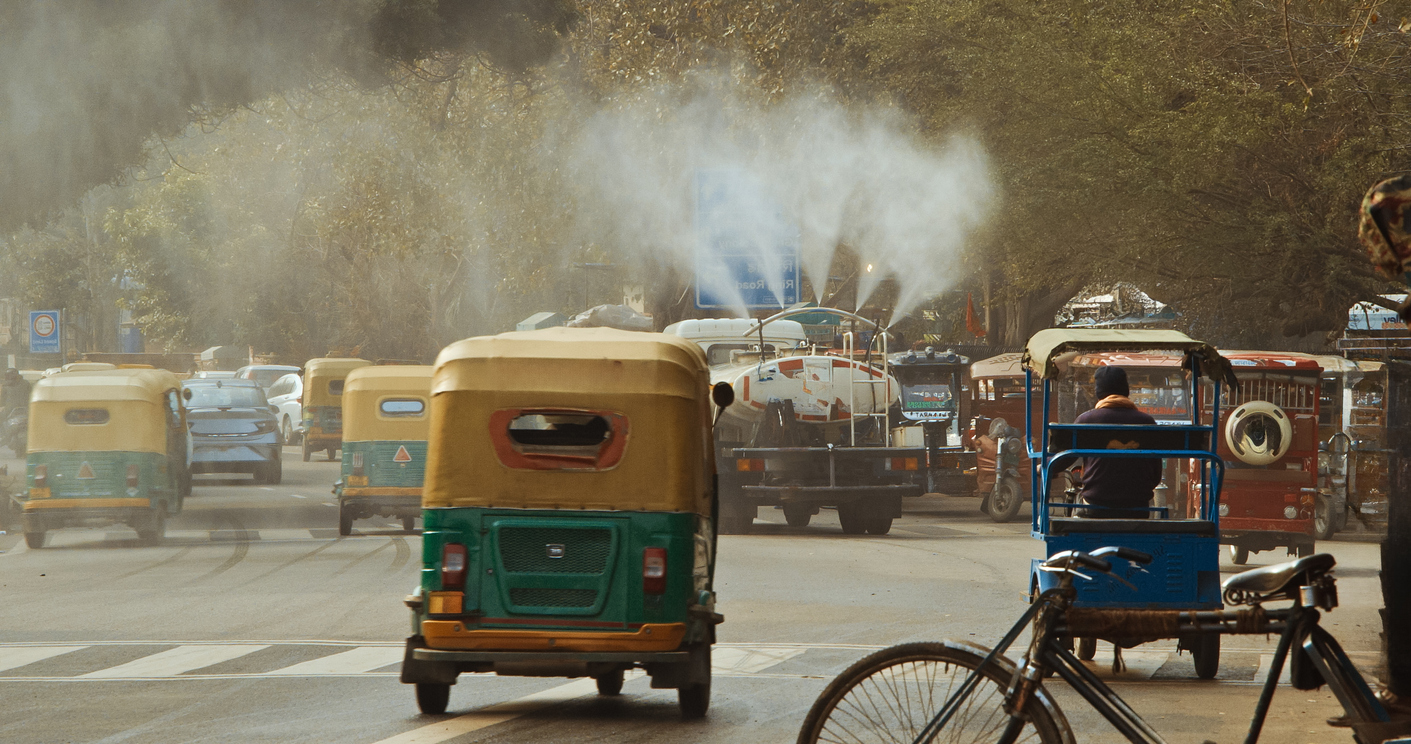Copyright thesouthfirst

Every breath you take travels to your brain: How air pollution triggers one in three strokes in India India continues to face one of the world’s heaviest air pollution burdens, with the State of Global Air 2025 report providing fresh insight into its evolving patterns. Synopsis: According to the latest State of Global Air 2025 report, air pollution is among the two top causes of deaths in India. While lung disease takes the hardest hit, with 67 percent of all Chronic Obstructive Pulmonary Disease deaths linked to dirty air, your brain faces an equally brutal assault. Stroke claims 36 percent of its victims through the toxic air swirling around us, according to the report. Picture this: Right now, as you read these words, microscopic particles smaller than a strand of spider silk enter your lungs, slip past your body’s defences, and embark on a journey through your bloodstream straight to your brain. This isn’t science fiction. This is the daily reality for virtually every person in India, where more than 5,500 people die each day from breathing the air around them. The death toll eclipses road accidents, violent crime, and most infectious diseases. The numbers tell a grim story: Over 2.01 million deaths in 2023 alone, nearly one in five of all deaths nationwide, according to the State of Global Air 2025 report. With 186 deaths per 1,00,000 people, India’s rate exceeds the global average and stands more than 10 times higher than in high-income countries. The global study found that India and China together accounted for more than half of the 7.9 million pollution-related deaths worldwide, highlighting South Asia’s central role in the global air pollution crisis. However, here’s what makes this crisis particularly devastating for stroke patients: While lung disease takes the hardest hit, with 67 percent of all Chronic Obstructive Pulmonary Disease (COPD) deaths linked to dirty air, your brain faces an equally brutal assault. Stroke claims 36 percent of its victims through the toxic air swirling around us, according to the report. More than one in three stroke deaths in India can be traced directly to air pollution. The study, conducted by the US-based Health Effects Institute and the Institute for Health Metrics and Evaluation (IHME), finds that India and China together accounted for more than half of these deaths, underscoring South Asia’s position as the epicentre of the world’s air pollution crisis. Further, for the first time, the report quantified the impact of air pollution on dementia, linking dirty air to a wide range of non-communicable diseases, including heart disease, stroke, chronic lung disease, diabetes and cognitive decline. Nearly 95 percent of the global population still breathes air that exceeds the World Health Organisation’s safety limits, and 36 percent of people live in countries without national air quality standards. In India, ambient and household pollution remain intertwined challenges. It also highlighted the government’s clean cooking initiative, the Pradhan Mantri Ujjwala Yojana (PMUY), as a transformative but unfinished effort that could avert around 150,000 deaths annually if households fully transition to cleaner fuels. Also Read: Air pollution and climate change putting unborn babies at risk The invisible pathway from the lungs to the brain When you breathe air laden with high PM₂.₅, fine particulate matter so small that 30 of these particles lined up would barely match the width of a human hair, enters your lungs. Your nose and throat attempt to filter them out, but PM₂.₅ slips through, sailing past your defences and diving deep into your lungs until it reaches the alveoli, those tiny air sacs where oxygen normally passes into your blood. But these particles don’t stop there. They’re small enough to punch through the delicate membrane separating air from blood. Now they’re inside you, literally inside your circulatory system, floating alongside your red blood cells like uninvited passengers boarding a train that runs directly to your brain. Their destination: Your arteries. Once there, these particles trigger inflammation, setting off alarm bells throughout your immune system. Your artery walls, under constant assault, begin to deteriorate. Fatty plaques build up. Blood vessels narrow. The inflammation makes these plaques unstable, like rust weakening the hinges of a gate until one day it simply collapses. When a plaque ruptures in an artery feeding your brain, blood flow stops. Brain cells begin dying within minutes. Stroke. Why stroke and pollution form a deadly combination The connection between air pollution and stroke operates through multiple pathways. The particles cause chronic inflammation in blood vessel walls, making them prone to developing atherosclerosis—the buildup of fatty deposits that narrow arteries supplying the brain. This inflammation also makes existing plaques unstable. A stable plaque might narrow an artery gradually over the years. An unstable plaque can rupture suddenly, triggering a blood clot that blocks blood flow to the brain entirely. Air pollution also increases blood pressure, another major stroke risk factor. The inflammatory response triggered by these microscopic invaders causes blood vessels to constrict and blood to become stickier, more prone to clotting. For someone already at risk — perhaps someone with high blood pressure, diabetes, or a family history of stroke — breathing polluted air multiplies the danger. The particles act as an accelerant, pushing vulnerable individuals closer to that critical moment when blood flow to the brain stops. This explains why 36 percent of stroke deaths trace back to air pollution. The invisible enemy travels from the air outside to the most vital organ inside your body, wreaking havoc along the way. India’s unequal battle with dirty air India continues to face one of the world’s heaviest air pollution burdens, with the State of Global Air 2025 report providing fresh insight into its evolving patterns. Even though household pollution from solid fuels has fallen over the past decade thanks to programmes like PMUY, outdoor air pollution, particularly PM₂.₅, remains dangerously high across the Indo-Gangetic Plain and many major cities. Annual average PM₂.₅ concentrations in many northern regions still exceed eight to 10 times the WHO-recommended limits, while urban areas face ongoing emissions from transport, industry and construction dust. Rural regions, meanwhile, continue to contend with crop residue burning and residual biomass use. Trends over time showed a mixed picture: Household air pollution has fallen significantly, but ambient pollution has improved only slightly or plateaued in most cities. Children are particularly vulnerable, with long-term exposure linked to pneumonia, impaired lung development, and cognitive effects, adding to the overall disease burden. Researchers noted that India’s challenge lies in addressing both indoor and outdoor exposures simultaneously. Sustained health gains will require coordinated action: Tightening emission controls, expanding renewable energy, improving real-time monitoring, and enforcing standards at the city and regional levels. Mapping exposure at fine spatial scales also highlighted inequalities in who breathes the worst air. Poorer, densely populated districts often experience the highest pollution levels, meaning the health burden disproportionately affects low-income households, women, and children. The Indo-Gangetic Plain remains particularly vulnerable, with pollution from vehicle emissions, industrial discharge, construction dust, and crop residue burning creating a toxic cocktail that hangs in the air for months during winter. Interview: Pollution, pigeons and cold weather conspire to spike respiratory illnesses in children How the study measured the world’s air The State of Global Air 2025 drew its findings from the Global Burden of Disease (GBD) 2023 dataset, compiled by IHME. This database merges air quality data from hundreds of government monitoring stations with satellite observations and atmospheric chemistry models, and undergoes extensive peer review before publication. Since the validation process takes over a year, 2023 represents the most recent fully verified global data available. To ensure consistency, the study used a harmonised global framework rather than separate national models. This allows direct comparison of exposure and disease estimates across 204 countries under the same assumptions. The approach is particularly crucial in regions like South Asia and sub-Saharan Africa, where ground-level monitoring remains sparse. In such areas, satellite-derived estimates fill data gaps, ensuring that even remote populations are represented. Behind these figures lies a three-dimensional (3D) spatiotemporal model, which simulates how pollutants such as PM₂.₅, NO₂, and ozone move and transform in the atmosphere over time. It accounts for wind patterns, temperature, humidity, and topography to estimate annual concentrations for every 0.1° grid cell on Earth. By linking these modelled exposures with population density, the study calculated population-weighted averages, a measure of how much pollution people actually breathe where they live. The model focused on long-term exposure, rather than short-term pollution spikes, since chronic contact with polluted air drives diseases like heart attacks, strokes, and dementia. This combination of globally comparable, peer-reviewed data and advanced modelling makes the State of Global Air one of the most authoritative sources on how air pollution affects human health worldwide, and specifically in India. Policy, health and people’s perspective The findings underscored that air pollution is not just an environmental issue but a major public health challenge. Many pollution-related diseases, such as COPD, heart disease, and dementia, often go undiagnosed or are detected late, especially in rural areas where community health centres (CHCs) and primary health centres (PHCs) struggle with staffing and resources. Strengthening diagnostic capacity and early intervention is crucial to reducing premature deaths and long-term disability. Air pollution also interacts with other non-communicable disease risk factors, including unhealthy diets, physical inactivity, and sedentary lifestyles, meaning that solutions must be multi-pronged. Addressing these lifestyle factors alongside environmental interventions can improve overall health outcomes and quality of life, especially for senior citizens and children. Experts recommend integrating programmes such as PMUY, NCAP, renewable energy initiatives, and public awareness campaigns. Community- and school-based education on healthy habits, clean cooking, and air quality awareness can complement regulatory efforts and empower people to take action at the household level. Practical solutions, therefore, include: Stricter emission controls for industry and transport Expansion of clean fuel programmes Renewable energy adoption Enhanced monitoring and enforcement Strengthening health systems and early diagnosis Awareness campaigns targeting schools, families, and communities Together, these measures can reduce exposure, prevent disease, and save lives, making clean air both an environmental and social imperative. India’s battle against air pollution is complex, persistent, and inequitable, but not insurmountable. The State of Global Air 2025 report shows that data-driven insights, robust monitoring, policy integration, and community action can guide effective solutions. Clean air is achievable, but it requires coordinated efforts across sectors, from government initiatives and city-level enforcement to health system preparedness and public engagement. (Edited by Muhammed Fazil.)



